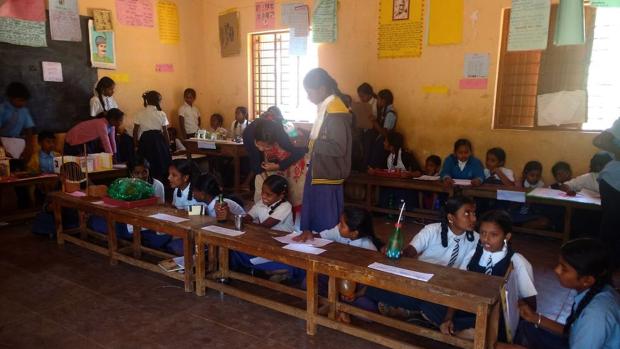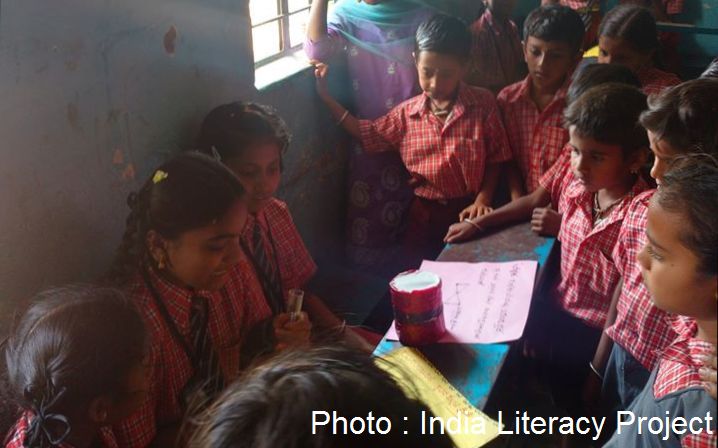
Photo: India Literacy Project
‘Energy is the ability to do work’, proclaimed a voice and about 40 of us nodded our heads and repeated this aphorism. If you paused and asked what is ‘work’, ‘it is the transfer of energy, you silly’, the voice would say. And such definitions popped out one after another like a bag of popcorn in the physics class.
The algebra classes were always busy finding the ever-missing ‘x’ tangled in a vicious maze of equations; geometry classes gave us a sense of purpose by solving the greatest obstacle of life -- the theorems, step-by-step. If you have been fortunate enough to go to a school, I am sure you can relate to the trauma these classes would have been, at least for most.
Not that the teachers were bad, of course, most were dedicated and motivated to teach. It was probably the method they followed -- the rote learning that we have been so used to, thanks to the exams that judged our memory rather than our intellect. At the end, your future depended on how much you could recollect during the exam, irrespective of how much you did or didn’t know.
And things haven’t changed much during the last three decades of my life. There are still physics classes popping out those definitions, mathematics classes churning out equations and chemistry classes spelling out the hymns of chemical reactions. But, there is a small wind of change -- a realisation that this method is NOT WORKING in making kids smarter! And that, is a welcome realisation.
“Teaching science the way we do dulls the child's mind and children are only able to reach the minimal possibilities of their real capabilities”, opines Mr. Arvind Gupta, a well-known toy inventor and popularizer of science, who is famous for his science education initiative called Arvind Gupta Toys that turns trash into toys for kids to understand science better.
“The horrendous way in which science is taught at school gives children a distaste for life about this beautiful subject. Children soon develop a block for science and math. That is why, we call our activities ‘Toys from Trash’ without mentioning ‘science’ anywhere”, he adds, talking about the motivation behind his initiative.
Enter fun, exit rote
A new approach taken by a handful today in teaching science is to incorporate the element of ‘fun’ and ‘play’ in lessons learnt at school, instead of the monologue of teachers. Touching and feeling is one of our senses for a good reason. We are born to ‘touch’ and ‘feel’ anything we come across to absorb and understand it better. And science lessons are no different!
“Children's life is motion, and learning is a very dynamic activity - making things, pulling things apart and putting them back again. It has been proven that activities help children relate science to the real world - also with their immediate surroundings”, says Mr. Gupta citing the example of the Hoshangabad Science Teaching Program started in the 1970s that was one of the first attempts to rejuvenate science teaching. “It started as a science activity program using low-cost resources and made science fun for over a lakh children studying in government schools. Prof. Yashpal came as the first teacher trainer and spent 15 days with village teachers. The HSTP spread to over a 1000 rural schools and ran for 25 years”, he exclaims, recognising its huge success.
It is hardly surprising to see this need for ‘play’ echoing from many around us. “As a student, I loved computer science and chemistry and when I look back at why that was the case, though other subjects were equally interesting, I can think of one thing that stood out about these two subjects -- the sense of inquisitiveness”, shares Mr. Bharath Cheluvaraju, a successful computer scientist who currently works for a Bangalore based start-up. “That sense of inquisitiveness”, he says “was mostly attributable to the toys that I was meddling with -- the computer running my programmes and the magnetic chemistry activity set I was gifted.”
“These experiences were so influential that when I had to choose my stream of study for my undergraduate course, pursuing computer science engineering or majoring in chemistry were my obvious picks”, recollects Mr. Cheluvaraju on the impact the sense of play and fun had in shaping his career and future.
A common misconception in the society today is that the fun comes at a cost. The numerous schools that advertise fancy labs and teaching equipments to give a ‘hands-on’ experience to the kids in this journey of learning are mostly unaffordable for the majority. But does learning right have to be so expensive?
“The other bogey that India is a poor country and can't afford science activities has been belied by many innovative and low-cost experiments throughout the country. You need not be a rich school to do science experiments. Instead, you need vision. We must move beyond the idea of a stereotypical science lab - with fancy test tubes and pipettes locked up in the glass cupboard with a grime of dust meant for the school inspector! Science is all around us and we can use so many ordinary things to bring back the fun of science into the lives of the poorest children”, argues Mr. Gupta.
Here is a simple example to illustrate why learning science right does not cost you a fortune. If you were to explain to a kid in 7th standard about how to detect the presence of electric charge, you would give him an electroscope, the instrument to detect electric charge, to do so. Now, buying a simple electroscope online comes with a price tag of about INR 2500 (40 USD) which is way out of reach for most in our country. But how about making one yourself with some wool, paper, cardboard pieces, plastic pipes and copper wires that cost close to nothing? That is what Mr. Gupta’s toys are all about!
“We have documented over 1500 science projects, activities, toys on our website www.arvindguptatoys.com in short videos, photographs and books. These are all for free downloads in the public domain. Our videos in 20 languages have been viewed by over 59-million people worldwide”, says Mr. Gupta with a sense of achievement. In addition, the website has over 5000 passionate books on Education, Science, Math, Environment, Peace and other children's books available for free. “Everyday over 10,000 books are downloaded. This just shows the hunger for good books in our people”, he quips.
Teachers -- orchestrators of the carnival
“It is the supreme art of the teacher to awaken joy in creative expression and knowledge”, said Albert Einstein. Teachers are undoubtedly the ones entrusted with a huge responsibility of shaping a generation with scientific temper, sense of enquiry and rational thinking.
While there are passionate individuals like Mr. Gupta who are trying to simplify science and make it fun, science teachers today need to utilise such aids to bring out the best in each student. And that starts with enabling these selfless souls (teachers) with all that they need to have.
“As a nation, we must restore the dignity of teachers - give them much higher salaries and social status so that the best in society aspire to become teachers”, opines Mr. Gupta citing the example of Finland where all brightest 12th class students wish to become elementary school teachers. And then there are various government schemes to train and empower teachers with innovative teaching methods, and also help students get the best experience during their learning.
“A year back, the Govt. of India took a great initiative of setting up Atal Tinkering Labs in over 500 schools with a vision to 'Cultivate one Million children in India as Neoteric Innovators'. This is to give children a feel for good activities, project making and a chance to unleash their creativity. This move - coming so many years after independence is to be heartily welcomed”, he remarks.
If science teachers shoulder the responsibility of producing the best and innovative minds of the next generation, what should they look like? “A good teacher is one who can tell children that I KNOW NOTHING -- a person who is a fellow discoverer with the children”, opines Mr. Gupta.
“It is very difficult for adults with degrees to come to the level of the child. Teachers need to read about great experiments in education in our country and all over the world. How many teachers have heard, much less read, Divaswapna - by Gijubhai Badheka? He was inspired by Montessori and ran a school in Bhavnagar, Gujarat for 20 years and did ground breaking experiments in education. His classic book Divaswapna is perhaps the most creative treatise on education which came out of India in the last century. On Teacher's Day every teacher must read it”, he signs off with a piece of advice.
As we celebrate the 55th Teacher’s Day today, let us take this opportunity to thank every teacher who played a great role in making us who we are. And for those teachers who are teaching science, here is a wish to make it fun and enjoyable rather than rote and mundane!







